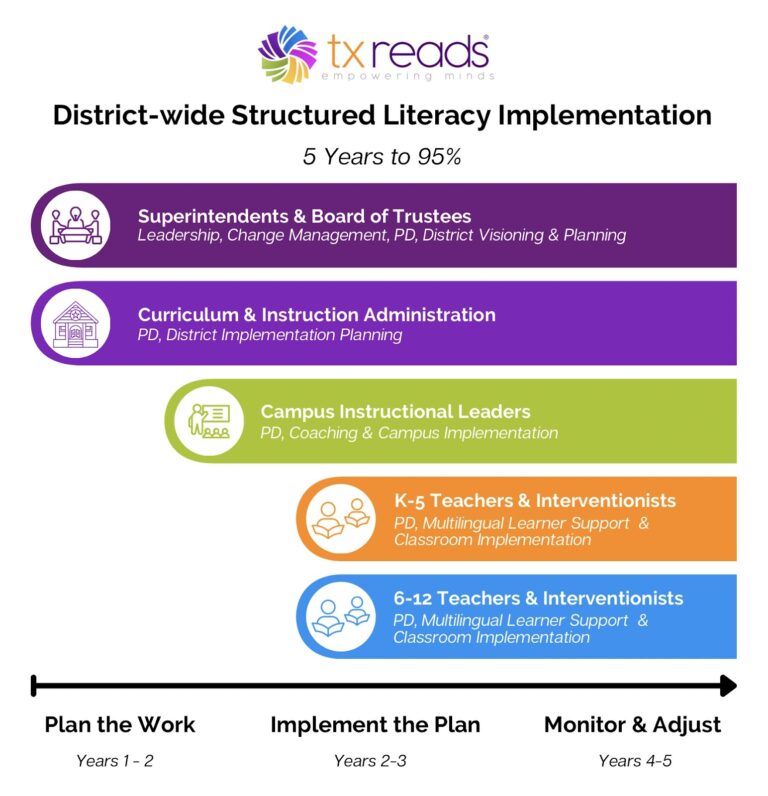Literacy challenges and solutions in Texas
A growing group of states are making a commitment to implement literacy programs based in the science of reading and to equip teachers with the skills needed for district-wide, school, and student success. Texas is on that journey of transformation. In the post, Laura Steward, Chief Academic Officer of 95 Percent Group and Pamela Toman, executive director of TX Reads, discuss steps to the implementation and evidence-aligned instruction for structured literacy.

Literacy is a civil right
Dr. Tracy White Weeden, President and CEO of Neuhaus Education Center, has a passion and commitment to literacy as a civil right; she reminds us that literacy is the currency in a knowledge economy. Tracy introduced me to the writings of a fellow Texan, Dr. M. Ray Perryman, and I read with interest his recent syndicated column called “Lone Star Literacy,” in which he addresses literacy as currency in an overall economy. He refers to literacy as an “economic imperative” and cites this statistic from The Program for the International Assessment of Adult Competencies (PIACC): “60% of Texas adults lack the basic capacity to be part of the state’s skilled workforce” (Perryman, 2022). He goes on to compute the economic cost of this reality as the loss of 186,000 jobs and $16.4 billion in annual gross product for Texas.
Texas is working hard to change that story and “positively impact student literacy achievement.” The state passed House Bill 3 and 4545, requiring all districts to shift to a phonics-based curriculum for reading and provide accelerated instruction. Research shows that instruction based in the science of reading can support nearly all children in learning to read at or approaching grade level. I think Texas is on the right road and an example for other states on why this matters, what the challenges are, and how to bring change.
Prioritize knowledge and leadership
I’ve been thinking a lot about how the “trickle up” effect that literacy has on our economy makes it even more imperative that we get it right. Certainly some of the “macro-efforts” such as policy, legislation, and teacher preparation are critical, yet this also invigorates our call to urgent action at the district, school, and classroom level. In that arena, I believe we are making headway with educators, as evidenced by the proliferation of science-of-reading professional development, webinars, journal articles and books, organizations, and of course social media. As I work with teachers around the country I find not only more awareness around evidence-aligned instruction, but many big, broad efforts around implementation. This is great news!
But implementation is a heavy lift. At the recent Big Sky Literacy Conference, I had the opportunity to lead a panel discussion around “conversations for change.” The panelists were all practicing educators who had led their schools or districts in a journey of transformation from balanced literacy to structured literacy. The factor that made the most difference, and was cited again and again, was leadership; having an administrator or administrative team who were not only well-versed in the science of reading, but willing to tackle systemic change.
When I think about the Texas movement for literacy, I always think about my friend and fellow literacy warrior Pamela Toman, executive director of TX Reads. Pamela knows a great deal about leadership and change management, so I invited her to share her thoughts here.

Two key changemakers: coaching and materials
TX Reads has been working with teachers, administrators, and superintendents to implement structured literacy in classrooms since 2017. Starting in 2020, Texas K-3 teachers and elementary principals are required to attend the Texas Reading Academies to learn the science of teaching reading. This “macro effort” by the Texas legislature is intended to drive change in instruction and materials from balanced literacy to structured literacy. The Texas Reading Academies, however, are not a panacea. The reading academies provide teachers with extensive information about the science of teaching reading. They do not address the breadth or depth of campus and district support required to replace balanced literacy with structured literacy. In order to bridge the science of reading to classroom instruction, teachers need a range of implementation supports including instructional coaching and classroom materials that align with the science of teaching reading.

Understanding the cognitive science
District leaders, including superintendents and school board members, often play central roles in establishing the district-wide environment that impacts classroom teachers and instruction. Leaders and administrators must be versed in the science of reading in order to address the complex challenges associated with implementing structured literacy. In Why So Many Kids Struggle to Learn Natalie Wexler points out that “Teachers continue to be trained in ways that ignore the findings of cognitive science.” This includes leaders. Understanding the cognitive science behind learning to read is critical to embracing why schools must move away from balanced literacy to structured literacy. Leaders also need to be willing to tackle complex multi-year system change because structured literacy implementation truly is a heavy lift. TX Reads recommends leaders create and implement a comprehensive literacy plan addressing all variables required for a successful and sustainable district-wide structured literacy implementation.
Most education leaders are not trained in the science of reading. TX Reads is working with our partners to develop products and services that explicitly meet the needs of leaders based on their role within the district. Each training pathway systematically integrates with the other pathways to streamline efforts across the district. This vertical and horizontal alignment of efforts at various levels within the organization reduces conflicts and increases efficiencies.
Individual and incremental training solutions for educators will not produce the change required to address the “economic imperative” to create a literate workforce. TX Reads is therefore dedicated to providing affordable and scalable solutions that make a range of science-of-reading training and tools accessible to educators who serve critical roles within school districts. This, of course, is exactly what structured literacy is intended to do for children.
Learn more
If you are interested in learning more about 95 Percent Group LLC, please contact us today. To learn more about districtwide structured literacy implementation, contact TX Reads.
About Pamela Toman
Pamela Toman cofounded Literacy San Antonio, Inc./TX Reads to systematically improve children’s reading outcomes. Literacy San Antonio, Inc. (dba TX Reads) is ranked in the top 5 of non-ESC Texas Reading Academies. TX Reads uses reading data, reading research and advanced business systems to develop and administer effective and affordable 21st century learning programs and services for in-service educators. She has worked with university faculty, reading researchers, public school administrators and elementary teachers to systematically change early reading instruction to align with the science of teaching reading.
About Laura Stewart
Laura Stewart, Chief Academic Officer, is a nationally recognized Science of Reading and Structured Literacy advocate and expert who serves as the company’s spokesperson and continues to build its thought leadership position in the literacy market. Stewart has dedicated her career to improving literacy achievement at leading education companies including The Reading League, Highlights Education Group, and Rowland Reading Foundation.



